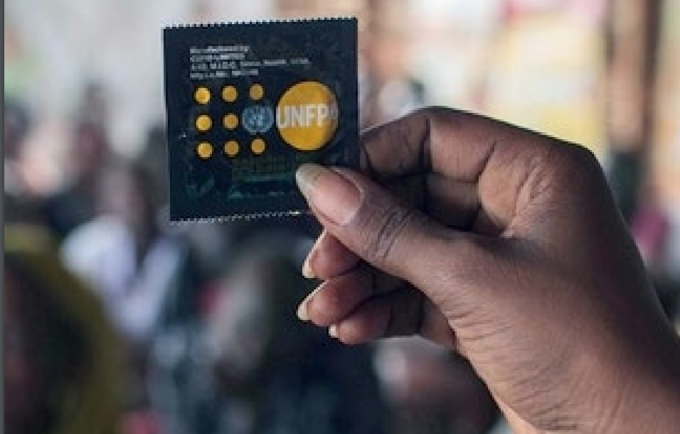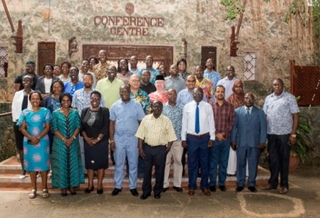Workers in health centres tasked with the reporting of the status of Family Planning commodities heaved a sigh of relief following the introduction of a mobile app known as QualiPharm. The mobile app promises to eradicate instances of poor data quality and delays in reporting while significantly reducing the workload since it will do away with the tedious paperwork that has been the norm within the health centres. An initiative of Health Strat with support from the United Nations Population Fund (UNFPA), QualiPharm was piloted in Homabay County in June 2019 where 130 healthcare workers including commodity managers from 100 health facilities were trained on how to use the new reporting tool. The tool, a first of its kind following over a decade of manual reporting, has been described by Dr. Fredrick Okari as having significant benefits.
Dr. Okari, a pharmacist at Suba County hospital in Homa bay, has used the manual reporting for 13 years. The mobile app will enable the health workers to collect, manage and use data more efficiently for decision making. According to Health Strat Chief Executive Officer Dr. Andrew Nyandigisi, the advantage of QualiPharm lies in its ability to run on any android platform device making it easily accessible. Further, the application allows for real-time reporting and data synchronization thus commodity managers within the health centres at the sub county, county and national levels will have an easier time coordinating their tasks while ensuring visibility and accountability. Digitization of family planning commodities was arrived at following a 2018 assessment by UNFPA on the supply chain management challenges that were being experienced by health workers in nine counties. The assessment revealed that the lack of accurate data that was being experienced was due to multiple disintegrated health systems at the sub county, county and national levels. In addition, the manual paper-based reporting is tedious and many times, it results to delays in reporting. Consequently, QualiPharm was developed through digitization processes of the manual Facility Consumption Data Reporting and Requesting (FCDRR) tool which is used by healthcare workers to report data on medicines for specific programmes such as family planning, malaria, HIV, and tuberculosis. The end result of the digitized process is the availability of timely and accurate FP commodity status data which is used to come up with rational orders thus averting stock outs. This ensures uninterrupted supply of FP commodities for effective service delivery. A quantitative evaluation that will measure the changes in the key indicators as a result of the innovation will be undertaken to inform scale up. www.kenya.unfpa.org Monthly Magazine| Issue #2 July 2020 Monthly Magazine| Issue #2 July 2020 15 Photo: Dr. Osborne Olago, a Pharmacist at Rachuonyo District Hospital holding a tablet for reporting FP commodities Gains made by QualiPharm I.
Improved data visibility at last assurance Through QualiPharm, the amount and quality of data going into KHIS such as quantities received, quantities consumed and ending balances of each product at the sub-county level has increased. Using this information, commodity managers at the sub-county and county levels are able to monitor stock status of each commodity at the end of each reporting month hence increasing visibility of available stocks in the facilities which helps to inform decision making such as redistribution of commodities. “Because of improved visibility on the status of commodities at facility level, I am able to see and make decisions on the facilities that need resupply of commodities, the quantities required and how soon they need those supplies.” Said Dr. Magdalene Ongas, County Pharmacist Homabay County In Homa Bay County, data visibility has been enhanced through improved reporting rates from 92% in June 2019 to 100% as at end of March 2020 as per data on Kenya Health Information System. II. Improved data quality for decision making The QualiPharm tool has an in-built data validation rule and a multilevel review and approval process which gives alerts for overstocking, wrong entries and irrational orders at the county and sub-county facilities. This has enabled the officers at the facilities to report accurate consumption data and ending balances onto KHIS for accurate forecasting and quantification to address actual needs hence reduce wastage of resources and avert stock outs and loss through expiries. The improved availability of accurate data has led to informed decision making for commodity managers at the county, sub county and facility levels. This includes; redistribution of commodities, order rationalization and targeted supportive supervision in the county. In addition, actual commodity needs for the county is available and hence accurate budgeting for commodities. III. Reduced burden of reporting In Rachuonyo District Hospital, the tool has tremendously simplified the process of data collection and reporting while reducing transcription errors during data entry processes, according to Dr. Osborn Olago, a sub-county Pharmacist “With QualiPharm, there is less paperwork and filling of forms at the facility level. Initially, this presented a huge challenge due to the high number of reports submitted monthly to the sub county Pharmacist. Previously, once I received reports from health facilities, I had to again enter the data into District Health Information System, now I only get an alert that a report has been uploaded for review and click approve to upload data onto KHIS,” he observed. He added that travelling costs have reduced and the long hours spent delivering reports from dispensaries and health centres to the sub county hospitals are now a thing of the past. IV. Integrated system Data from QualiPharm has been synchronized with the KHIS at the Ministry of Health and will also be linked with the Logistics Management Information System (LMIS) which is currently under development at KEMSA. The integration of QualiPharm into the national network has improved visibility of family planning commodities and quality of data from the sub-county facilities. Future Plans Following the positive experiences reported in Homabay County, QualiPharm is currently being rolled out to Isiolo, Kilifi and Migori counties with over 250 health workers targeted for training on reproductive health supply chain including forecasting and quantification. UNFPA has donated 100 android tablets to facilitate health professionals to capture and transmit data in real time from health facilities onto QualiPharm. In addition, counties have been called upon to take up the cost of internet bundles and maintenance of the gadgets in the next budget cycle. This is following reports by health workers that they do not have access to adequate data bundles and the tablets are prone to breakages thus hampering their reporting. UNFPA country office is working with the department of reproductive and maternal health on the use of QualiPharm to improve reporting on family planning commodities at the health facility level. Hence, Scale-up of QualiPharm to other counties is significant to further strengthen the management and use of health commodities and improve the use of data for decision making at all levels of the health system. www.kenya.unfpa.org M



